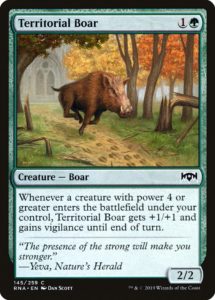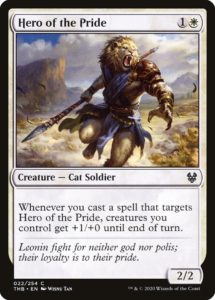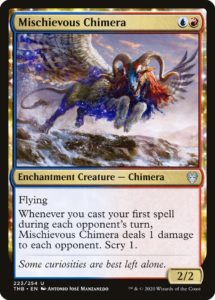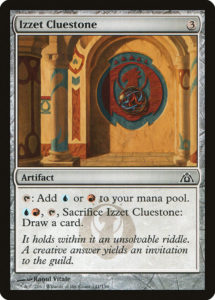We often say this, but Magic is a massive game. It has over a hundred mechanics, between its keywords, keyword abilities, keyword actions, and ability words. Long ago, Magic treated its (non-evergreen) mechanics as disposable, things to be explored within a block and then never seen again. That ended when 2002’s Onslaught brought back one of Magic’s stronger mechanics, Cycling. Since then, we’ve seen familiar mechanics return, reimagined, and remixed over the years, linking past players to the present and building upon well-understood design ground.
Micro Returns
A more recent innovation has been the rise of mechanic callbacks on individual cards. Emry, Lurker of the Loch has Affinity for Artifacts, Deep-Sea Terror has Threshold, and Gallia of the Endless Dance essentially has Battalion. This allows previous, often popular mechanics to return without needing them to be set themes. Note that none of these creatures actually have those mechanics printed on them, and for good reason: every vocabulary word in Magic adds a bit of complexity. This is an obvious barrier for newer players, but the complexity applies to everyone. There’s a cognitive load to keeping track of how many mechanics are in a given set and what they do, and remembering mechanics only on a single card each is an unnecessary load.
Sometimes these mechanics return in tweaked forms. Gallia of the Endless Dance doesn’t actually have Battalion, since she doesn’t have to attack as a Warmind Infantry does. Thousand-Year Storm provides a weaker version of Storm (a mechanic that will never again be in Standard, but can be on this single card). Devouring Hellion has Devour 2, but unlike Thorn-Thrash Viashino, can also eat Planeswalkers. Oathsworn Knight has an updated version of Phantom Nantuko‘s never-named mechanic. Without the freedom to tweak returning non-keyworded mechanics, Bane of Bala Ged couldn’t reference Annihilator 2 while being slightly different. These cards benefit from returning one-of mechanics not being keyworded by virtue of being able to remix and experiment.
There’s also the fact that some mechanics are ability words. Ability words—like Landfall, Morbid, and Constellation—have no rules meaning, cannot be referenced by cards, and have diverse effects (rather than always doing the same thing, like Awaken X, Explore, or Extort). It’s possible to build a deck around Adamant, but Magic doesn’t and can’t have Adamant-matters cards. Just compare Clockwork Servant to every other Adamant card and recognize that it actually works differently than all the rest. There is no benefit to putting Landfall on Tireless Tracker, since that ability word’s only purpose in Zendikar was to key people into a major set theme.
So, mechanics return, they don’t get their keywords when they’re not a set theme, and that’s the status quo we’ve known for quite some time. And then 2019 reintroduced a familiar face.
Not Formidable, but…
Ferocious was the least-liked mechanic in 2014’s Khans of Tarkir. It struggled to make sense in blue, but was a fine workhorse mechanic. 2019’s Ravnica Allegiance brought it back on four cards. That’s perhaps the most a returning, previously named mechanic appeared without getting a name, but it was so diffuse you weren’t going to build a deck around it. Then the next set, War of the Spark also brought Ferocious back on four cards. This time, it was a bit stronger and focused in two colors. Three sets later, it’s back again, this time as the RG theme, and it’s on seven cards but still unnamed.
I’m not sure why R&D became so enamored with Ferocious, but it’s indicative of a trend over the past few sets. We’re increasingly seeing set themes designed around non-named mechanics. Eldraine had WU artifacts and enchantments matter, RG non-humans matter, and UR second card drawn matters. Theros Beyond Death has RG unnamed Ferocious, UR first spell on an opponent’s turn matters, and RW unnamed Heroic.
This trend is worrying. First and foremost, it’s harder to talk about Magic without names to fall back on. Magic learned the importance of names when people asked why 1999’s Mercadian Masques had no new mechanics—the Spellshaper, Rebel, and Mercenary mechanics aren’t keyworded. It’s more difficult for newer players to follow a set’s guideposts when the guideposts don’t call attention to themselves. But there’s more this problem.
The Goodstuff Problem
Unnamed mechanics tend to receive less support than their named counterparts. They have fewer things to enable them, fewer rewards for doing the thing, or both. For example, let’s compare Heroic in its first and latest incarnations. In the original Theros, there were twelve common or uncommon Heroic creatures. There was ample support for them thanks to the Bestow mechanic. In Theros Beyond Death, there are five Heroic creatures. They’re all in red-white, only one fewer than Theros’ six RW heroes. The mechanic is even more focused in THB, since it works the same on all its creatures (it could be a keyword here, whereas it had to be an ability word in THS), but lacking Bestow, it’s harder to trigger.
Heroic plays pretty well in THB, but it’s much less powerful than it was the first time around. This isn’t inherently a problem, but weaker mechanics provide weaker synergistic payoffs. Where synergy is weaker, raw card power becomes more important. The focus shifts from drafting archetype-specific pieces to drafting goodstuff decks. Decks begin to look similar regardless of their color combination. For example, black-red in THB is almost never a sacrifice-matters deck; it’s a mix of good black and red cards with a bit of oomph given to sacrifice outlets and Portent of Betrayal.
Having moderately-supported unnamed mechanics in sets may be increasing the overall “soupiness” of Magic. This trend can make Limited easier to crack (since more decks will prioritize the same cards) while making it seem like Limited is harder to crack (since people will struggle more to recognize set themes). Making synergy harder to recognize is cool once and a while (especially in high-powered and difficult sets like Ultimate Masters), but it’s a problem if it crops up in every Standard set. Theros Beyond Death is less soupy than Throne of Eldraine, but things have been fairly soupy since Ravnica Allegiance (a set composed of five modular mechanics). Yet there’s another, potentially bigger issue at play: the mechanics that this new paradigm allows to exist.
Mechanics that shouldn’t be
Some of these unnamed mechanics were allowed to exist because of how minor they are, but might have been better off on the cutting room floor. None exemplifies this better than UR flash-matters in THB, a mechanic we’ve discussed at length. Twice. There are only five payoffs cards in the entire set. Sure, there are plenty of enablers, but Flash-matters is an incredibly dangerous mechanic because it lets players play draw-go Magic. So, the payoff cards were thoroughly nerfed so that an opponent wouldn’t be too scared to attack into an Arena Trickster that could trigger more than once a turn. You can’t proactively tap down blockers with Stinging Lionfish because the mechanic only works on your opponent’s turn. The UR theme is painfully undersupported, making it one of the weakest color combinations in THB.
It’s fine for UR to be a weak color combination—every color pair should have that honor every now and then. The issue is that the mechanic probably should have been abandoned in set design. If it’s this difficult to enable in Limited and isn’t intended for Constructed play, then what work is it doing? It’s a cool concept for kitchen table Magic, but if they couldn’t make Flash-matters work as the UR Limited pillar, they should have cut it as the Limited theme and tried again later.
I fear that these unnamed mechanics are being treated as more disposable than named mechanics—they don’t have to pull the same weight that Escape, Food, and Proliferate do, so it’s acceptable for them to not work as well. I won’t pretend that Cohort, Eternalize, and Revolt don’t exist, since named mechanics can have plenty of their own issues. But I worry that Wizards’ increasing reliance on unnamed mechanical themes will lead to more flash-matters, second card drawn-matters, and non-human matters.
How’d we get here?
Back around 2009, New World Order came into full effect, limiting complexity at common (and increasing it at uncommon). Since then, Magic has struggled to find the right balance of complexity. It has often overshoot, putting too many mechanics into sets (Dragon’s Maze, Battle for Zendikar) squeezing extra-complicated mechanics in alongside already full sets (Khans of Tarkir), and unnecessarily adding or replacing mechanics within a block (Eldritch Moon, Hour of Devastation). It has less often undershot desired complexity, most notably with 2017’s Ixalan (whose Limited environment suffered from the restrictions).
I think the increased reliance on unnamed mechanics comes at least partly from a desire to work around New World Order. Magic kept trying to put 3-5 mechanics into sets (with the goal being three) but kept putting in too many mechanics and complexity. But Magic’s had unnamed subthemes and tribal interactions (which almost never have named keywords) before, so why not use this technology to provide more mechanics without actually adding more mechanics? This makes sense in something like Ravnica Allegiance, where Ferocious was a tiny hook to help things along; but now we’ve just gotten two sets in a row, each with three mechanics-in-all-but-name that defined color pairs. This is one of the primary issues NWO was trying to avoid—too many mechanics—except the complexity is exacerbated by these unnamed mechanics being harder to keep track of. I can see the good intent beyond this potential choice, but I think it’s gone too far and is causing more problems than it’s solving.
Going forward, I’d love to see Magic either commit to using more named mechanics in sets or to stop relying so heavily on unnamed mechanics. Name ’em or don’t use ’em, but don’t half-commit to 30% of the color themes. And maybe give Ferocious a break, too? It’s been working really hard all year.
—Zachary Barash is a New York City-based game designer and the commissioner of Team Draft League. He designs for Kingdom Death: Monster, has a Game Design MFA from the NYU Game Center, and does freelance game design. When the stars align, he streams Magic (but the stars align way less often than he’d like).





